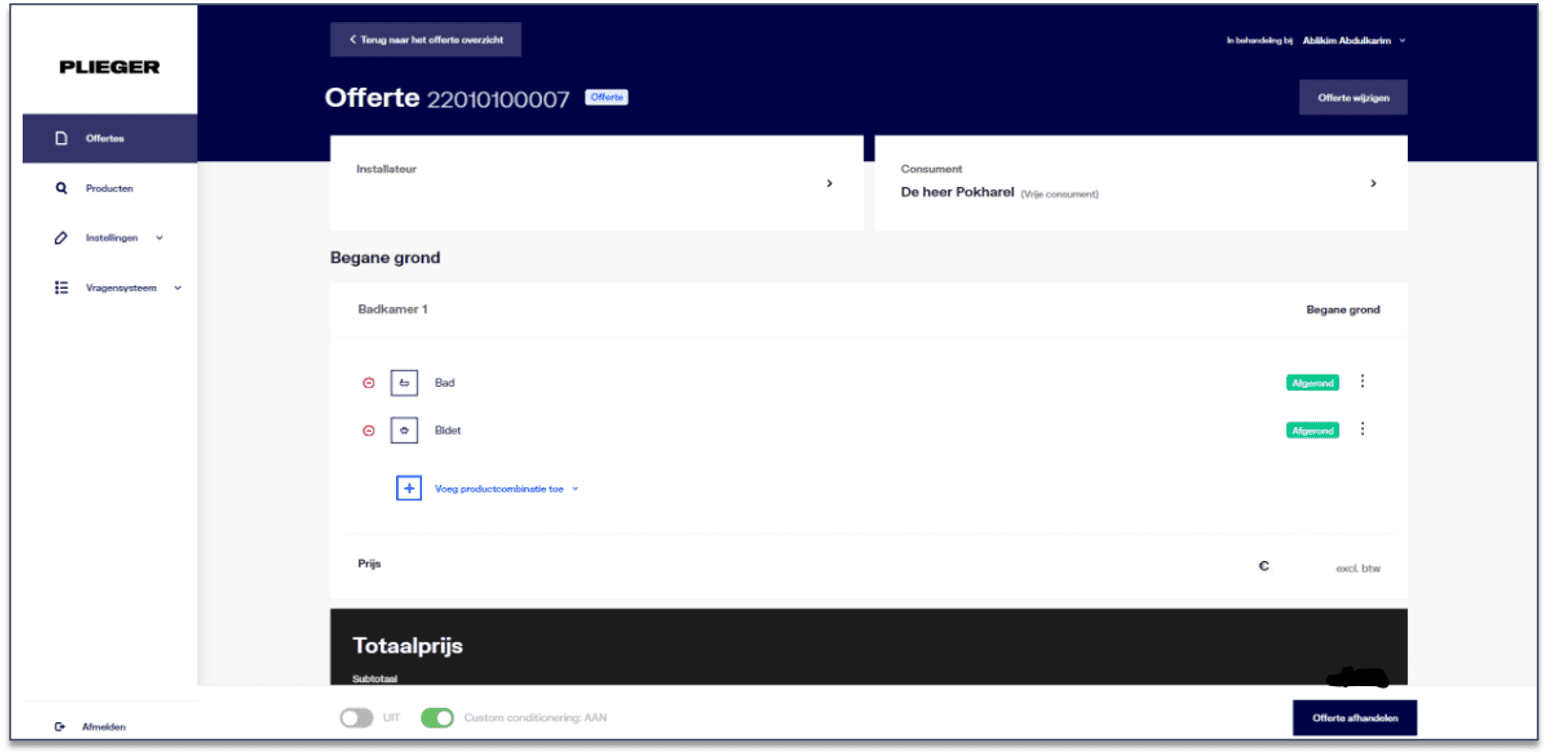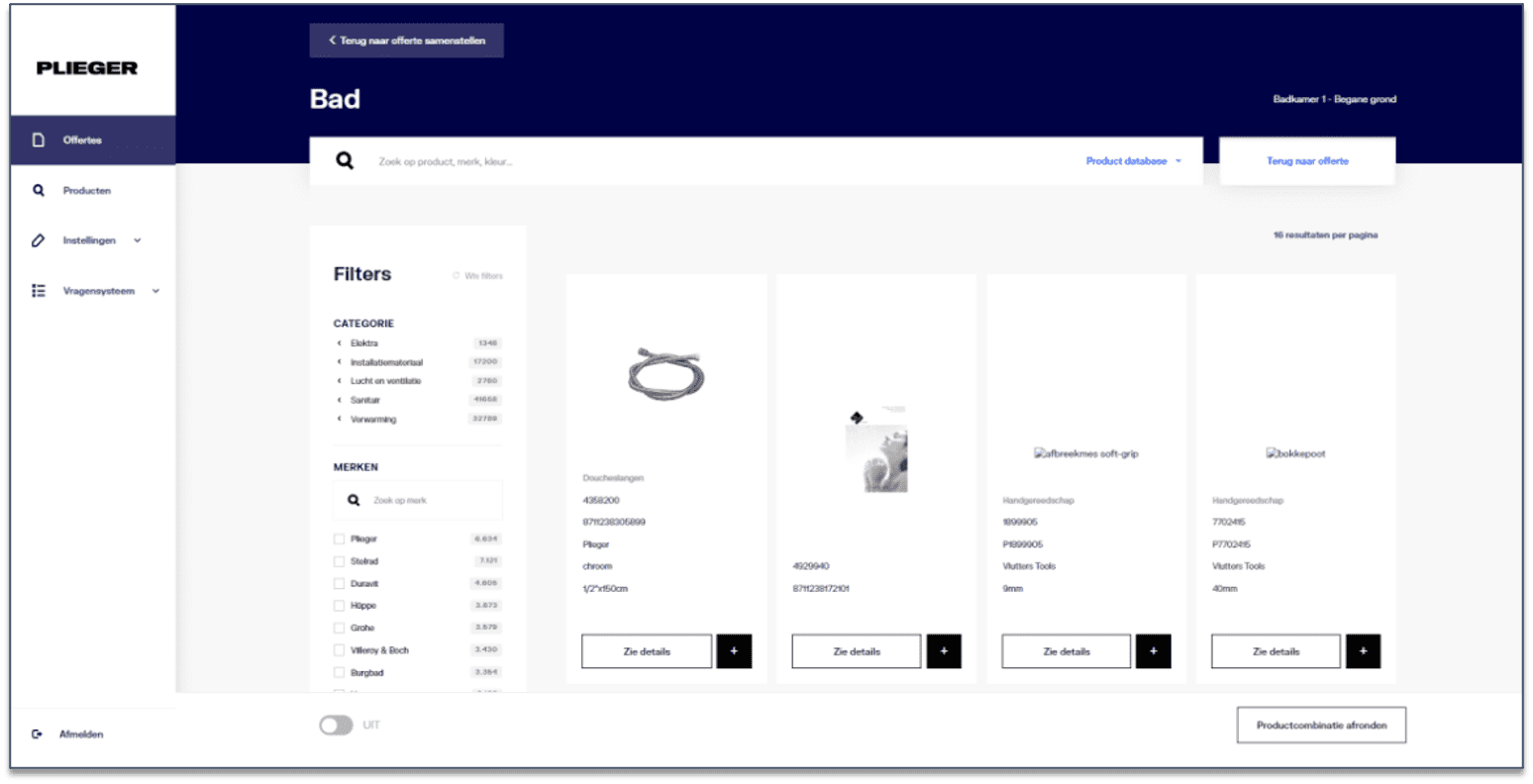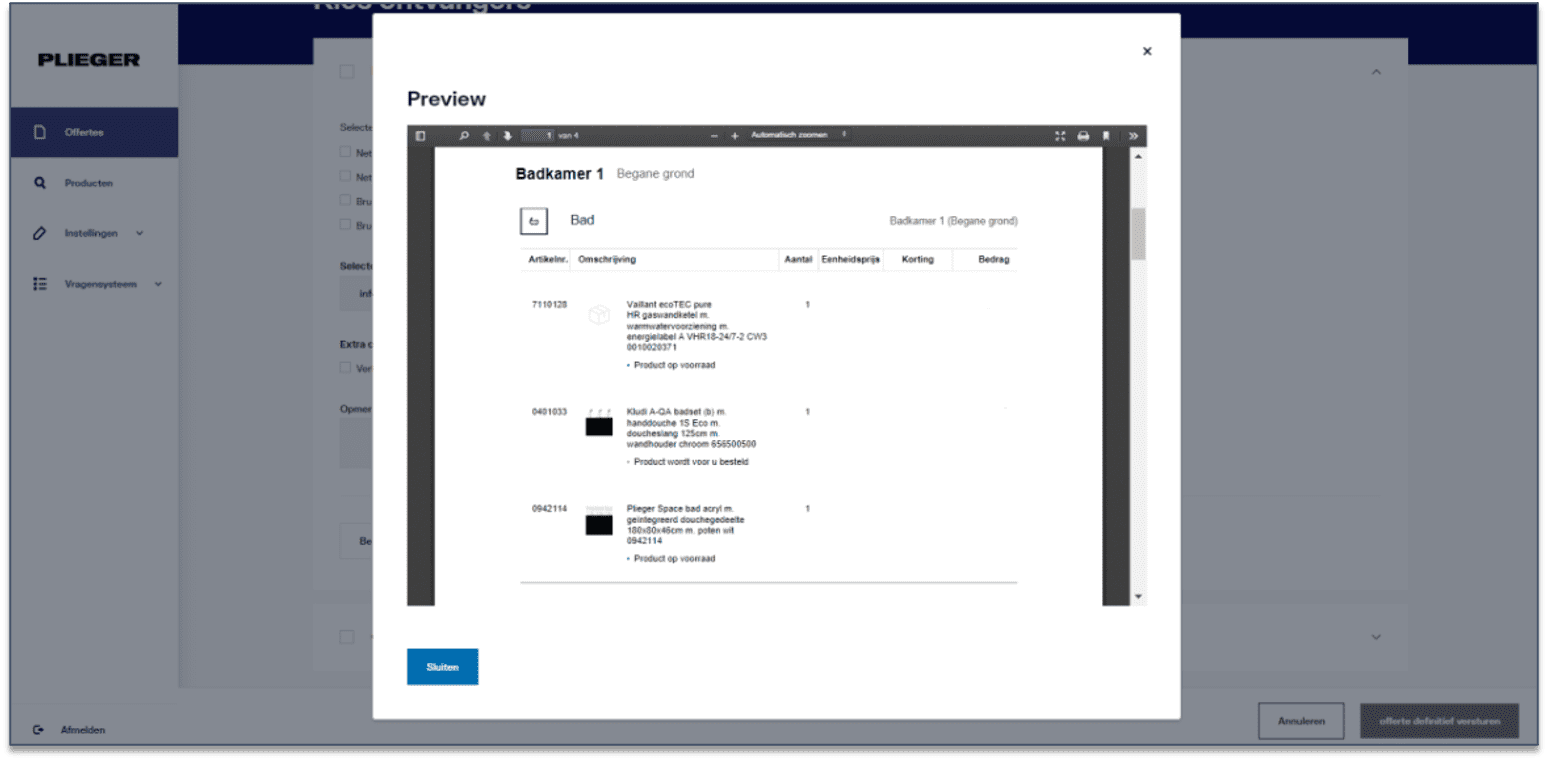Plieger Accelerates Quote Generation to Increase Showroom Sales
Retail consumers expect convenience on their path to purchase, whether it is checking product availability online before going into a store or visiting a brick and mortar showroom before making an online purchase.
The rise in e-commerce has made seamless interaction between digital and physical retail experiences the norm. These expectations could be felt by Plieger Group – the parent company of brands such as Plieger, ThermoNoord, Hoomie, and Memodo – who specialize in plumbing, heating, air & ventilation, and energy storage.
Foot traffic in Plieger’s 20 showrooms was not translating to proportionate sales due to a manual customer quote generation process. Plieger’s showrooms highlight a breadth of products for home projects – including tiles, bathtubs, and showerheads – which amount to a staggering catalog of over 150,000 items.
Plieger conducts their business in a B2B and B2C capacity, selling to and through installers and contractors, with their showrooms serving as a step in the end customer and installer journey to experience product quality and compare pricing before making a purchasing decision. To increase efficiency for their showroom sales teams and provide a more convenient customer experience, Plieger decided to build a new quote generation application.
However, a change in IT would be required to support this change in business operations, as an aging core system was unable to support this new way of working. The Plieger Group IT team took a holistic approach, adapting their team, processes, and technology, to deliver the new Showroom Application with low-code which has generated over 2,000 quotes since launching in August 2022.
Legacy Tooling Leads to Business Lag
Like many organizations, Plieger relies on a legacy ERP system to manage core internal processes. While the ERP system still satisfies many business needs, there are moments when its rigidity can make it challenging to provide updates or enhancements quickly.
One of these instances was in Plieger’s showrooms, where sales employees would work between a few different systems, including the ERP, to generate quotes for customers. The showroom experience is much bigger for Plieger than just creating an engaging environment for the end consumer to pick out hardware for their dream home. Efficiency in the showroom impacts how quickly the end consumer can make a final purchasing decision with the installer (Plieger’s primary customer), thus directly impacting overall sales pipeline. Andrea Berkhout, Plieger Group’s IT Manager, noted that showroom employees could only take 4-5 appointments a week because they were spending the rest of their time creating quotes.
Monique Klein has worked at Plieger for over 18 years and today is a Regional Showroom Manager. Klein observed challenges for employees in the field including manual note-taking and repetitive data entry – both of which could result in potential inaccuracy or slow delivery of quotes.
The process was functional, but not optimal, and Berkhout saw the potential to improve the experience both for employees and customers by delivering a more centralized and automated system. With Plieger’s employees selling, on average, €410K in products annually, the industry benchmark across Europe was closer to €700K, which presented massive upside through process digitization and optimization.
IT Change-Management Drives Business Transformation
Berkhout has taken a holistic approach to driving change within the IT group to improve business outcomes. This included choosing a proven development platform, adopting new processes for collaboration, and building a team of people who could bring varied and expert perspectives.
Before joining Plieger Group, Berkhout had over a decade of experience in IT Project Management, which often left her dissatisfied when projects would take years and never feel quite complete. She was introduced to Mendix in 2018 through a partner and never looked back.
By the time Berkhout joined Plieger Group in 2022 she came with a wealth of Mendix development and process knowledge. Development of the Showroom Application started in February of 2022 and was the team’s first foray into Agile work. “In the past, if we had a problem with a system, we would send an email to our help desk. Before this project, that was all the communication I had with IT,” said Klein, who ultimately became the application’s Product Owner.
Berkhout noticed the shift in excitement from her business colleagues as their collaboration improved. “You can see it in Monique [Klein], who grew so fast as a Product Owner. She’s learning to dream, and to prioritize during refinement – it’s so cool to see.”
Plieger’s business colleagues were not the only new ingredient in the development process. Berkhout had firsthand experience with Mendix as a force for change within her career, so looked to hire aspiring developers from different areas of the world who may not have as abundant employment opportunities in their home country.
“The Agile way of working is not the only thing I brought to Plieger, but also the mindset that not every employee has to be Dutch or come from the same background. My Mendix team represents six different nationalities,” she said. This diversity of backgrounds and experience creates a more forward-thinking and change-ready culture within the company as a whole.
Plieger Group also enlisted the support of Webflight, an expert Mendix implementation partner, to accelerate their first low-code project. Jaap van Leeuwen, a Mendix Consultant at Webflight, quickly understood the business objective.
With the guidance of Webflight and Berkhout, the broader Plieger team quickly adopted this new way of working and saw the beauty of iterative development. “They really let us teach them how to work this way, and it sparked their enthusiasm,” said van Leeuwen, “You could see after the first sprint we had some basic pages and a data model, but after the second sprint they would say ‘hey, there’s already stuff in there that we asked for and it’s only been a month.’ And from there it just kept expanding and expanding.”
Improving the End-to-End User Experience
The shift in development approach yielded quick results for the team, and the Showroom Application was completed by August 2022. The new application offers enhancements for Plieger’s employees such as:
- Improved product search and filtering functionality, allowing salespeople to look up and track customer preferences in real-time, and make quicker recommendations for related products
- Centralized product data, inclusive of dynamic pricing based on the installer or possible discounts, making quotes more accurate and reflective of real-time availability
- Automated quote generation via PDF and email, delivering an easy-to-read quote for both the installer and customer the same day they visit the store
“You have a main screen with quotations, filters, and you can see product imagery. From the overview you can see specifics such as who generated the quote, when the price is valid until, and if it has been accepted,” said van Leeuwen of the new interface.

The Showroom Application was built to centralize and streamline a multitude of data points related to products, materials, installers, and pricing, and syncs with Plieger’s product information system every two minutes. “Plieger has hundreds of thousands of products and over 50,000 installers, so you can already imagine how many rows of data that is. We needed to fetch that in real-time, so we made it into a REST API call. We also needed to stay up to date with the installer data, so we had a CSV import from one of their FTP servers where we automatically fetched the data, processed it, and checked for changes,” he added.

Automating this cross-checking and connectivity between products saves a substantial amount of time for employees. “If you sell a shower, you don’t only sell the shower head, but also the plumbing, what goes in the wall, the tap, the filter, and more,” added Berkhout. “Salespeople would need to find and pair these items together, but with the Showroom App if they start by selecting a bathtub, the application will say ‘you probably also need this item,’ which is a huge plus for the salesperson.”
“Working in the app, the whole offer can be made within 30 minutes for the customer,” said Klein. The end-result for customers is an easy-to-read PDF, inclusive of imagery, to make their final purchase decision easy. Showroom employees are now able to take more appointments and generate more quotes, increasing their sales pipeline.

“When Monique was onboarding one of the showroom employees, she told us that there was one employee who had been working there for two months and still didn’t really understand how to make a quote in the old system. She was onboarded into the new Showroom Application and understood how to generate a quote there within a day. It was a huge compliment, that the app was that intuitive and you could shrink employee training time from months to a day,” van Leeuwen said.
Plieger is now moving into phase two of the Showroom Application with an improved view for their primary customer – installers. “The installer will be able to see the quotation and then approve the quote within the application without having to call the salesperson. We’ll also give them the ability to add in their own prices for installation, because what we send to the customer is the cost of the product. With this next enhancement the installer can send the consumer a whole quotation with everything included.”
“I’m very proud of the whole app,” Klein said. “My fellow showroom manager, Peter van Nistelrooy, and I trained the staff ourselves because we were in the project from start to finish. The response from the team was so great, and that was the best compliment I could wish for. We created something that brings all of our disciplines into one app, and it makes our employees very, very happy.”
A Business Culture Ready for the Future
The work on the Showroom Application and within Andrea Berkhout’s group feels indicative of a larger shift within Plieger Group, who has set a strong vision to be a more change-ready organization. “Plieger is very conventional, but you see things are changing now,” she said.
That change includes a new outlook on IT projects – avoiding future monoliths, taking time to develop things the right way, and reassessing entire processes versus just tools. The team already has a growing list of future Mendix applications on the horizon, including one to scan toolbox barcodes and generate orders for the logistics team and an app maintain contracts and pricing.
On their new ways of working, Berkhout concluded, “The distance between the business and IT has historically been huge within Plieger, and I think Mendix makes that distance smaller. We took over the Showroom App and now we are doing the rest of development within Plieger Group itself, so we are very happy with that.”
To learn more about Plieger’s low-code journey firsthand, join us for a roundtable event – Digitalizing the Wholesale Industry – this June 15 in Rotterdam, The Netherlands.